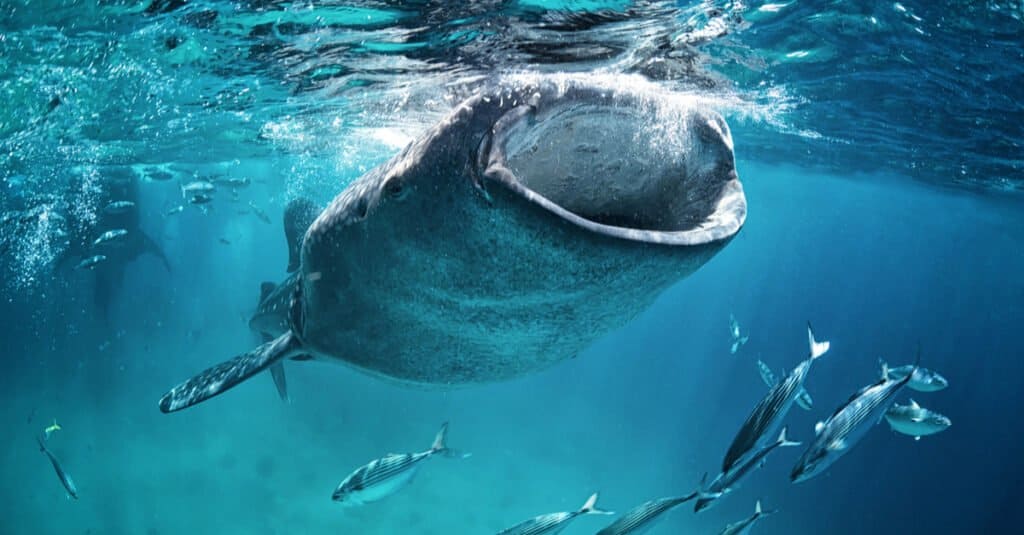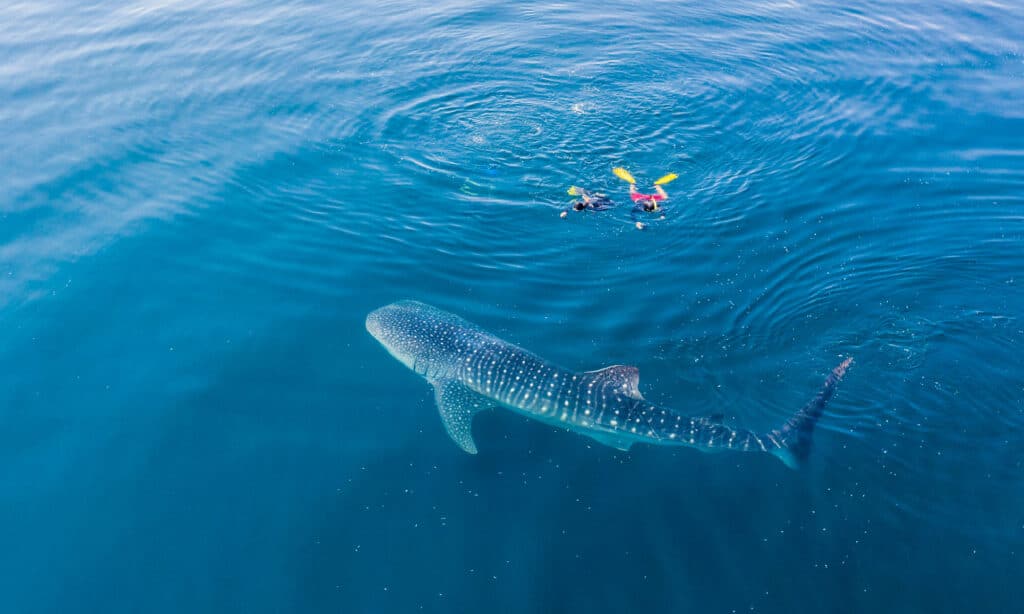Breaking down earth’s creatures into various categories is often useful for humans. It helps us understand their evolutionary background, identify, and even conserve the animals we are grouping. Still, we aren’t always perfect in the grouping process. Occasionally, we place an animal in a group that doesn’t belong, and some things need to be reorganized. Well, that happened only a few days ago! Since this new discovery, the title of “Earth’s largest omnivore” has officially changed. Let’s learn about the creature who now holds this title.
What is the largest omnivore in the world?

Whale sharks have officially been dubbed the largest omnivores on earth.
©Tee Wong/Shutterstock.com
The largest omnivore in the world has officially been changed and is now the whale shark.
Whale sharks aren’t new to holding records. In fact, before this new record of “largest omnivore” was bestowed upon them, they already held the record for “largest fish in the world“, “largest non-mammalian vertebrate in the world”, and a few others.
Historically, the whale shark has been grouped as a filter feeder shark, one of only three. These types of sharks are pretty rare, and include the whale shark, basking shark, and megamouth shark. Filter feeder sharks swim through the ocean and bring massive quantities of water into their mouths. As the water passes through their gills, rough pads in their mouths catch the heavy materials like krill and phytoplankton and route them into the stomach.
Why is the whale shark considered an omnivore?

Whale sharks mostly filter feed, but new studies show that they also eat seaweed.
©Fata Morgana by Andrew Marriott/Shutterstock.com
With a diet that primarily consists of krill, phytoplankton, fish eggs, and crab larvae, the whale shark has technically been known as a carnivore since the things it eats are small creatures. A recent study, however, seems to show a much-broadened diet for whale sharks, especially while in the open ocean.
This study took biopsies of whale sharks and examined them for a variety of things. During the studies, it was concluded that whale sharks don’t just feed on small sea creatures, but that they also feed on plant matter, too!
“This causes us to rethink everything we thought we knew about what whale sharks eat. And, in fact, what they’re doing out in the open ocean.”
Dr. Mark Meekan
With this new discovery, whale sharks immediately became the clear winner when it comes to omnivores. As the record-holders for a variety of other size-related awards, it’s no surprise!
The type of seaweed that was detected is known as Sargassum. Sargassum is a brown seaweed that is commonly seen floating around near the surface of the water. It often breaks off from the reef that it’s attached to and will float around in large mats. Whale sharks seem to be ingesting small amounts of this seaweed and have evolved the capacity to process smaller amounts of it. They still require krill and phytoplankton, but they aren’t too bothered if they happen to get some seaweed while they are at it!
How big are whale sharks?

Whale sharks are the largest fish in the ocean.
©iStock.com/Velvetfish
Whale sharks are some of the largest creatures on earth. In some instances, whale sharks have been recorded as over 60 feet long and weighing over 41,000 lbs (around 15 tons). The only creatures in the ocean that are larger than whale sharks are true whales (whale sharks aren’t actually whales).
The discovery seems to make sense to Dr. Mark Meekan, especially when he compares the largest animals on land with those in the water.
“In the sea, we always thought the animals that have gotten really big, like whales and whale sharks, were feeding one step up the food chain on shrimp-like animals and small fishes. Turns out that maybe the system of evolution on land and in the water isn’t that different after all.”
Dr. Mark Meekan
Do Whale Sharks Have Any Predators?

Blue sharks
are one of whale sharks’ few predators
©Pommeyrol Vincent/Shutterstock.com
Size can be a handy quality to have in the wild and in the case of these gentle giants, it most certainly is.
Hence it comes as no surprise that whale sharks have few predators. However, even the largest omnivore starts out life somewhat small-sized, leaving it vulnerable to the especially voracious which are never far away.
Blue sharks, blue marlins, orcas, and white sharks fall into that category and are known to hunt young whale sharks for dinner.
How long do whale sharks live?
If a huge size was not enough for you, these great fish have been know to have a lifespan of over 100 years! It’s amazing to think these mammoths are swimming around eating fish (and plants!) for over a century. The whale shark comes to adult age around age 30.
Do whale sharks hurt humans?
Despite having the word “shark” in their name, whale sharks don’t hurt humans. Before this study, they were usually considered carnivorous, but in a much different way than other sharks. Instead of killing prey like large fish, mammals, or even humans, whale sharks just swim around and gulp water, hoping to filter tiny creatures as they go.
As such, they don’t pursue or attack humans in any way. These oceanic giants are gentle and don’t attack other creatures. In fact, if a whale shark consumed a human by accident, it would likely kill the whale shark (and probably the human).
What was the record-holding animal before?

Kodiak bears previously held the record for the largest omnivores on earth.
©iStock.com/Jess Bray
Before the whale shark held the record for largest omnivore in the world, the holder was the Kodiak bear in Alaska. Kodiak bears are a regional distribution of brown bears (grizzly bears) that live on Kodiak Island in Alaska. Kodiak Island is incredibly resource-rich and allows the bears to grow to truly monstrous sizes. The largest Kodiak bear ever recorded was Clyde, a 2,400 lb brown bear that died in 1987. Although polar bears are larger than Kodiak bears, they are almost exclusively carnivorous and therefore excluded from this particular title.
The largest animal overall
The whale shark is the largest fish in the ocean and is now the largest omnivore in the world, but what is the largest animal overall? Simply put, the largest animal in the history of the earth is the blue whale. Blue whales aren’t just the largest creatures alive today, they are the largest creatures to have ever lived. On average, blue whales measure between 75 and 80 feet long and weigh between 290,000 and 330,000 lbs. For reference, it would take 40 elephants or 30 T-rexs’ to equal the weight of a single blue whale.
Up Next
We have some other great articles about whale sharks and other big critters.
- 10 Incredible Whale Shark Facts! Did you know about all of these?
- What Do Whale Sharks Eat? Their Diets Explained. What all do these monsters put on their plate?
- Top 10 Biggest Animals That Ever Walked the Earth. We have the list of the biggest of the biggest animals!
The photo featured at the top of this post is © Lindsey Lu/Shutterstock.com
Thank you for reading! Have some feedback for us? Contact the AZ Animals editorial team.







